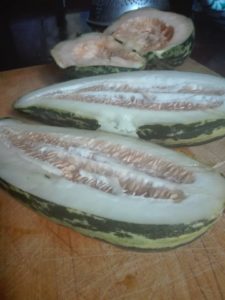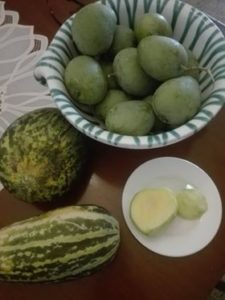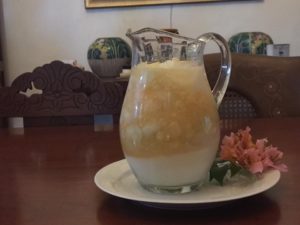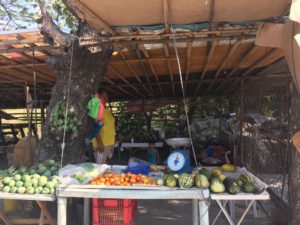Of Milong Tagalog, Indian Mangos, and Covid


Milong Tagalog (Tagalog melon) and Indian mangoes

Milong Tagalog in water mixed with milk and sugar, as a summer cooler
Today, on my way home from Waltermart, I saw this roadside fruit stand that was selling Milon Tagalog and “Indian” mangoes. Milon Tagalog (can’t find the English name for this) was a home table mainstay in my family when I was growing up. Mixed with water, sugar, ice, and evaporated milk, it is served as a refreshment, usually during lunch, on hot summer days. We cannot afford the more expensive Milon-Kastila (musk melon), hence the Milon Tagalog. They taste like cucumbers, so kids won’t eat them as they are. These are the times when I wished we could afford Milon Kastila. But as I grew older, I began appreciating this type of melon but the Malabo variety only. Now, what is a Malabo variety? Like squash, Milon Tagalog comes in two varieties. Google translates the word Malabo as obscure, murky, unclear, idiot even, so forget Google. Let’s say there is sticky (lagkitan) squash and the non-lagkitan (Malabo), hello? It is the same with Milon Tagalog; the only difference is that the Malabo variety is the preferred one because, unlike the Malabo squash, which has the texture of a cucumber, the Malabo Milon Tagalog is quite sticky. I hope I am not confusing you. Oh, well, next time you buy Milon Tagalog, ask for Malabo and the non-Malabo types to discover the difference. For Tagalogs like me, I bet everyone knows what I am talking about here. To see if the milon is perfectly ripe, get the ones with burst skin or cracks caused by moisture. As the melon gets riper, the skin splits, letting you see the flesh and the seeds. They’re the best. I got two kilos of the Milon Tagalog, which I hope my cook can prepare as a refreshment. Yes, she’s back for the nth time, but that’s another story.

The fruit vendor had a lot of Indian mangoes to sell. You know the type as opposed to Apol Mango. Search me, but I don’t know the origin of the names. I used to think that Indian mangos originated from India. I never bothered to ask. A novelty in the 60s – because we didn’t have much of them then; we only had the piko and carabao varieties – you can find them everywhere, and no one seems to care about them. They taste like “kerosene,” people say. I like them, though — not the green ones, but those that are crunchy and yet ripe. I used to like sour green mangoes, especially when dipped in bagoong (anchovy sauce), but I cannot eat them now, the tart green mangoes. The bagoong, yes, any time!
The Apol (apple) mango, on the other hand, (I bet the Pinoys invented the name because of the fruit’s appearance: reddish skin like an apple’s) is similar to the ones I see in supermarkets in Europe. Imports from Brazil or could be from any other Latin American country. The Mangos from Brazil, they are called in Vienna. Does anyone remember the movie The Boys from Brazil? The title may lead you to think is porn, but sorry to disappoint my gay friends: it is a thriller novel by American writer Ira Levin and made into a movie with the same title. Get yourself a copy.
I told the fruit vendor that I don’t like sour mangoes. No, they are not, she assured me. And I want them yellowish like golden yellow inside but not yet ripe. Oo, sir, promise, she was quick to reply, so I got two kilos of them. I sighed because, on a happier occasion, I could get them from our Mayor’s trees, baskets of them at times and gratis. I was drooling when I got home and asked my cook to peel one for me. With salt? She asked. Yes, with salt. They’re not yellowish at all, well, a bit of yellowish but not the yellowish I crave. Oh, never mind. One bite and my face was the most wrinkled face you can ever imagine.
“Shit, ang asim! “(so sour!) the mangos I mean, but my face, too. I cannot eat them, the mangos. Indian mangos are the only green mango I can eat because when a bit ripe, they are not so sour, unlike the carabao mangos that can stimulate my head skin pores to open making my head and whatever is left of my hair, wet.
Whatever sympathy I had earlier for the fruit vendor turned into a rage. Well, a bit of it. I told her I was surprised that she sells fruits on the roadside. The coronavirus Lockdown forbids trading on the roadside.
“When you go hungry, you don’t listen to prohibitions, “was her reply. The produce she sells was from their farm. They have a lot, and they cannot sell them. Their farm where they grow them is in another town, and therefore they cannot bring them to the market in my hometown. Last week much of their harvest went to garbage when they started to rot. And next week their watermelons are ripe for the pickin’, but they don’t know what to do now. Whatever they can harvest, they sell at the roadside at the risk of getting caught and fined. Don’t you get financial help from the local government for your loss? I asked. No, they don’t. I am sure they will get compensated, but of course, it’s wishful thinking. I hope that they will get help from the concerned authorities.
Now I am starting to get worried that the talks about chaos this pandemic may bring could become a reality when people are hungry, and there was nothing to eat. You cannot eat Milon Tagalog and Indian mangos every day. They, too, will become so expensive and people with little money, or no money at all, cannot afford them. I can only think of scary movies like that helicopter scenario in Ms. Saigon when the American Embassy was evacuating people but could only take a handful, leaving a bunch of Vietnamese scared and crying at the gates. I am reminded of this when the AustrianForeign Ministry sent a message to all Austrians outside the country, asking them to register if they want repatriation to Austria. Holding an Austrian passport, I registered and got a call yesterday asking me if I want to join a repatriation flight on March 30. I decided to stay here until the date I booked to go back. I was worried the first time I received this notification because it sounded urgent.
I then quickly realized that they are doing this in case of an emergency. And also for those Austrians stranded in a country with a virus outbreak. All those arriving in Austria by plane must go on mandatory quarantine for 14 days. Like many other Austrians, I live in an apartment in Vienna – condo they call them here – and I must stay there until the time when my house arrest is over. Where I live in the Philippines, I have a big huge garden with fruit trees and bougainvilleas. I can always step out of the house, and immediately I am in commune with nature without having to go out past the gates of my property. I am free to move around, noticing hardly that the lockdown could be over. So I am staying, hoping for the best, expecting for the worst. Bahala na (Come what may) as we, Pinoys, are quick to say when faced with a crisis like this one. Lilipas din yan (it will pass). Bahala na. Que sera, sera!
So many things to be grateful for, Badik. At least you have an option. Forgive na the fruit vendor for trying to make a living. Let the rest of the Indian mangoes ripen. Keep safe. I hope Walter is ok in Vienna.
Forgiven and forgotten na. :) Dropped by her roadside fruit stand today to get more Tagalog milon. She told me that there was this rumour that the palengke, pharmacies, groceries, etc. will close starting April 1 so she’s worried. Told her that it’s not gonna happen. Our Mayor has not said anything about that. Also, it’s on April 1, come on! True enough, our mayor, in a message today said that it was just another fake news. Some people can be so irresponsible
You made the right decision to stay. At least you are in mansion with your huge garden around, unlike in Vienna when you are “imprisoned” in an apartment for days.
I know. I’ll go nuts but not Koko-nut hahaha